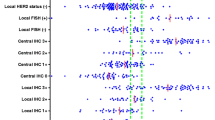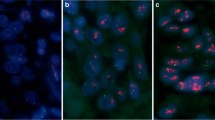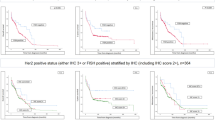Abstract
Background
Accurate HER2 testing is of great clinical value for the identification of breast cancer patients who are eligible for trastuzumab therapy. The aim of this study is to review breast carcinomas diagnosed from 2001 to 2007 at a Spanish National Reference Centre for HER2 testing, evaluating the agreement between HER2 immunohistochemical (IHC) tests and fluorescence in situ hybridisation (FISH) tests.
Methods
Demographic and clinical information was obtained from 2751 breast carcinoma patients. HER2 IHC and FISH tests were performed both in a local laboratory and in the reference centre. The HER2 IHC0/1+, IHC2+, IHC3+ and FISH-positive patients comprised 64%, 20%, 16% and 24% of the available population, respectively (results from the reference centre). Using statistical approaches, we evaluated the agreement between: (1) HER2 IHC and FISH tests, and (2) results provided by the local and the reference laboratories.
Results
The data confirmed a statistically significant relation between HER2 overexpression and amplification. We also found that instances of polysomy 17 and heterogeneous patterns of HER2 expression (heterogeneous staining distribution in different areas of the same tumour) are more frequently observed in HER2-positive tumours. Finally, since the diagnoses were made from 2001 to 2007, we could also observe a rising agreement rate between laboratories/pathologists with time.
Conclusions
HER2 testing is most accurate when performed by experienced pathologists and at a high-volume reference laboratory. Polysomy 17 and HER2 heterogeneous staining patterns should also be considered for a better understanding of the variation in the anti-HER2 therapeutic response.
Similar content being viewed by others
References
Ferlay J, Bray F, Pisani P, Parkin DM (2004) LOBOCAN 2002: cancer incidence, mortality and prevalence worldwide [IARC CancerBase No 5, version 20]. IARC Press, Lyon
Pollan M, Ramis R, Aragones N et al (2007) Municipal distribution of breast cancer mortality among women in Spain. BMC Cancer 7:78
Esteva FJ, Sahin AA, Cristofanilli M et al (2002) Molecular prognostic factors for breast cancer metastasis and survival. Semin Radiat Oncol 12: 319–328
Early Breast Cancer Trialists’ Collaborative Group (EBCTCG) (2005) Effects of chemotherapy and hormonal therapy for early breast cancer on recurrence and 15-year survival: an overview of the randomised trials. Lancet 365:1687–1717
Vogel CL, Cobleigh MA, Tripathy D et al (2002) Efficacy and safety of trastuzumab as a single agent in first-line treatment of HER2-overexpressing metastatic breast cancer. J Clin Oncol 20: 719–726
Sauter G, Lee J, Bartlett JM et al (2009) Guidelines for human epidermal growth factor receptor 2 testing: biologic and methodologic considerations. J Clin Oncol 27:1323–1333
Bauer KR, Brown M, Cress RD et al (2007) Descriptive analysis of estrogen receptor (ER)-negative, progesterone receptor (PR)-negative, and HER2-negative invasive breast cancer, the so-called triple-negative phenotype: a populationbased study from the California Cancer Registry. Cancer 109:1721–1728.
Guarneri V, Broglio K, Kau SW et al (2006) Prognostic value of pathologic complete response after primary chemotherapy in relation to hormone receptor status and other factors. J Clin Oncol 24:1037–1044
Wolff AC, Hammond ME, Schwartz JN et al (2007) American Society of Clinical Oncology/College of American Pathologists guideline recommendations for human epidermal growth factor receptor 2 testing in breast cancer. Arch Pathol Lab Med 131:18
Wolff AC, Hammond ME, Schwartz JN et al (2007) American Society of Clinical Oncology/College of American Pathologists guideline recommendations for human epidermal growth factor receptor 2 testing in breast cancer. J Clin Oncol 25:118–145
Al-Dujaily EA, Al-Janabi AA, Pierscionek T, Yasseen AA (2008) High prevalence of HER-2/neu overexpression in female breast cancer among an Iraqi population exposed to depleted uranium. J Carcinog 7:8
Kitano Y, Umemura S, Ohbayashi H et al (2007) Assessment of a new anti-HER2 monoclonal antibody, SV2-61gamma: a best concordance with HER2 FISH. Appl Immunohistochem Mol Morphol 15:389–393
Dybdal N, Leiberman G, Anderson S et al (2005) Determination of HER2 gene amplification by fluorescence in situ hybridization and concordance with the clinical trials immunohistochemical assay in women with metastatic breast cancer evaluated for treatment with trastuzumab. Breast Cancer Res Treat 93:3–11
Tsuda H, Akiyama F, Terasaki H et al (2001) Detection of HER-2/neu (c-erb B-2) DNA amplification in primary breast carcinoma. Interobserver reproducibility and correlation with immunohistochemical HER-2 overexpression. Cancer 92:2965–2974
Cuadros M, Talavera P, López FJ et al (2010) Real-time RT-PCR analysis for evaluating the Her2/neu status in breast cancer. Pathobiology 77:38–45
Merola R, Mottolese M, Orlandi G et al (2006) Analysis of aneusomy level and HER-2 gene copy number and their effect on amplification rate in breast cancer specimens read as 2+ in immunohistochemical analysis. Eur J Cancer 42:1501–1506
Downs-Kelly E, Yoder BJ, Stoler M et al (2005) The influence of polysomy 17 on HER2 gene and protein expression in adenocarcinoma of the breast: a fluorescent in situ hybridization, immunohistochemical, and isotopic mRNA in situ hybridization study. Am J Surg Pathol 29:1221–1227
Hyun CL, Lee HE, Kim KS et al (2008) The effect of chromosome 17 polysomy on HER-2/neu status in breast cancer. J Clin Pathol 61:317–321
Zhao J, Wu R, Au A et al (2002) Determination of HER2 gene amplification by chromogenic in situ hybridization (CISH) in archival breast carcinoma. Mod Pathol 15:657–665
Chibon F, de Mascarel I, Sierankowski G et al (2009) Prediction of HER2 gene status in Her2 2+ invasive breast cancer: a study of 108 cases comparing ASCO/CAP and FDA recommendations. Mod Pathol 22:403–409
Vanden Bempt I, Van Loo P, Drijkoningen M et al (2008) Polysomy 17 in breast cancer: clinicopathologic significance and impact on HER-2 testing. Clin Oncol 26:4869–4874
Lal P, Salazar PA, Ladanyi M, Chen B (2003) Impact of polysomy 17 on HER-2/neu immunohistochemistry in breast carcinomas without HER-2/neu gene amplification. Mol Diagn 5:155–159
Moriki T, Takahashi T, Ueta S et al (2004) Hormone receptor status and HER2/neu overexpression determined by automated immunostainer on routinely fixed cytologic specimens from breast carcinoma: correlation with histologic sections determinations and diagnostic pitfalls. Diagn Cytopathol 30:251–256
Author information
Authors and Affiliations
Corresponding author
Rights and permissions
About this article
Cite this article
Cuadros, M., Cano, C., López, F.J. et al. HER2 status in breast cancer: experience of a Spanish National Reference Centre. Clin Transl Oncol 13, 335–340 (2011). https://doi.org/10.1007/s12094-011-0663-4
Received:
Accepted:
Published:
Issue Date:
DOI: https://doi.org/10.1007/s12094-011-0663-4




